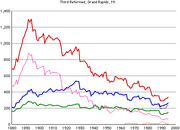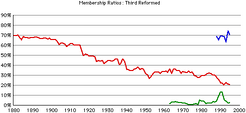
Third Reformed Church, Grand Rapids, MI, 1876-1968
History[]
Third Reformed was organized in 1875 as a daughter church of Second Reformed, which, according to Baxter, "had grown beyond the ability of one pastor to attend to the wants of its 500 families and 700 or more members." Distances to the church were long for some members, so they looked for a large neighborhood with sufficient church members to support a new congregation. The movement was sanctioned by Second Reformed and by the Classis of Grand River, which organized Third Reformed church on October 1, 1875, with 62 members. Another 46 followed within six months after, making a total of 90 families in April 1876.
At the time of its organization, Third Reformed occupied the sanctuary on the northeast corner of Hermitage and Diamond, which was dedicated in August 1875. This was was enlarged in 1876 and again in 1886 to seat about 800. Rev. A. Kriekard of Kalamazoo accepted Third's call and commenced his pastorate on Feb. 1, 1876. In 1878 a parsonage was built on the northwest corner of East and Holbrook Streets.
Baxter notes, "About fifty of the members reside in the country, and almost the entire congregation is suburban nominally, but practically part and parcel of the city population."
Rather than add English language worship services, Third remained an exclusively Dutch language congregation, which helped give rise to Bethany Reformed, and English-only church, being started not very far away in 1893.
In 1969, the congregation lefts its urban location for a more suburban space at 2060 Michigan NE.
Visit the Third Reformed Church website.
Historical Details[]
Locations[]
- 1009 Hermitage SE at Diamond, 1876-1968
- 2060 Michigan NE, 1969-present
Pastors[]
- Adrian Kriekard, 1876-1902
- Albert W. De Jonge, 1903-05
- Ablert Vanden Berg, 1906-18
- Nicholas Boer, 1918-39
- Harry A. Van't Kerkhoff, 1940-44
- George C. Douma, 1944-46
- Henry Zylstra, 1947-50
- Anthony G. Van Zante, 1950-54
- Jay R. Weener, 1955-60
- H. A. Dykstra, 1960-66
- Peter M. Paulsen, assistant, 1967-70
- Stuart J. Blauw, 1968-74
- Owen T. Bechtel, 1974-78
- Richard Bates, 1979-83
- Lawrence J. Doorn, 1984-90
- Kent A. Fry, 1991-2008
- Dennis TeBeest 2010-present
Daughter Churches[]
- Sixth (later Oakdale Park), 1889-1974, merged with Everglade to form New Life
- Bethany, 1893-1994, merged with Fairview to form Orchard Hill
- Immanuel , 1907, cosponsored with Bethany
- Calvary Reformed (later Common Ground Community), 1915, cosponsored withBethany
Membership Overview[]
Total membership peaked in the early 1890s and went into decline as Third Reformed launched daughter churches by itself (Sixth to the south in 1889 and Bethany, an English-language congegation just a few blocks from Third, in 1893) and with its daugher church, Bethany (Immanuel to the sourch in 1907 and Calvary to the east in 1915).
Prefessing membership didn't peak untll the early 1930s, and membership was in fairly consistent decline ever intil about 1990.

Membership data, Third Reformed Church, Grand Rapids, MI
Overall Membership Data[]
Heavy lines: green (lower) shows membership in families; blue (middle), professing members; red (top), total members. Thin lines: magenta (middle), non-professing members; orange (lower), inactive members; black (top), average worship attendance.

Membership ratios, Third Reformed Church, Grand Rapids, MI
Membership Ratios[]
Red line (middle) shows nonprofessing members as a percentage of total membership (inactive members exluded); green (lower), inactive members as percentage of total membership; and blue (higher) average worship attendance of total membership.

Five year growth rate, Third Reformed Church, Grand Rapids, MI
Five Year Growth Rate[]
Red line shows five year growth rate. A five year growth rate between 10% and -10% is considered stable; greater than 10% indicates a growing congregation; one below -10% indicates a church in decline. This makes no allowance for daughter churches. Data source: Acts of Synod of the Reformed Church in America. Dates are year prior to publication date since data is gathered at the end of one year and published in the next.
Sources[]
- History of the City of Grand Rapids, Michigan , Albert Baxter, 1891. Especially the section on Third Reformed Church